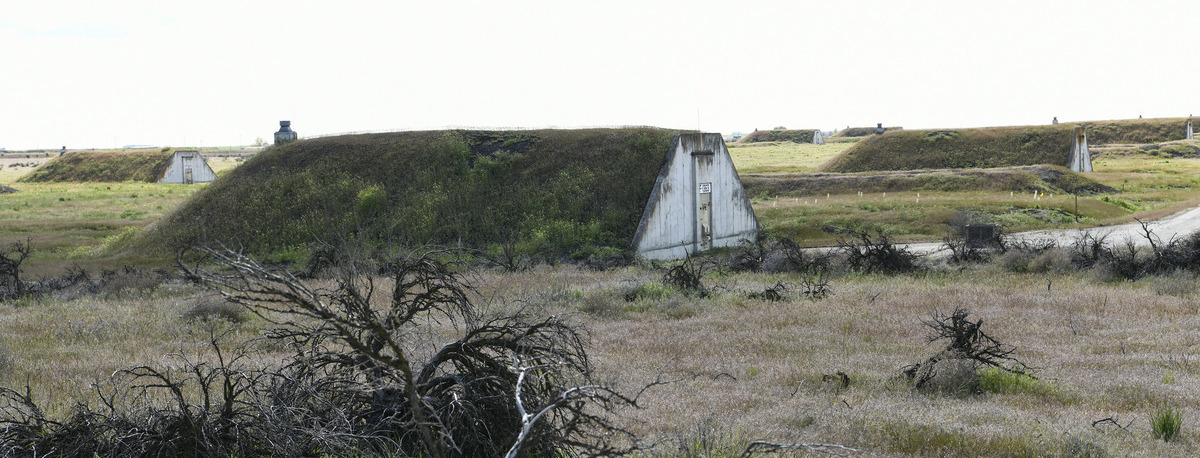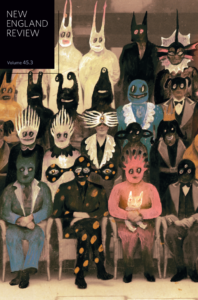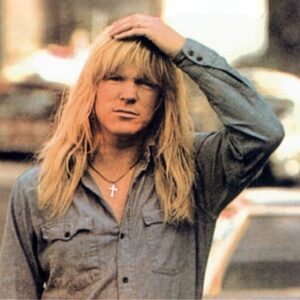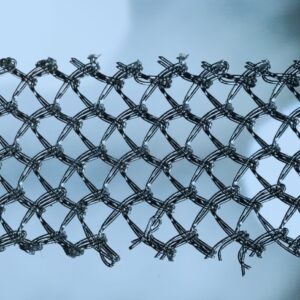
A Golden Land? Questioning Frontiers, Fantasies and Fulfillment in the Pacific Northwest
Rachel Greenley Considers Our Illusions of Progress and Productivity While Exploring the Ruins of the Umatilla Chemical Depot
I’d first driven by this land en route to elsewhere. When I saw the bunkers—over a thousand set upon the desert—I was so stunned by the terrain’s alien disfigurement that I stopped at an overpass to absorb the view. To my eye, the concrete bunkers were dystopian in their sum and structure and sprawl—scarring nine thousand acres of flat northeastern Oregon land.
In time, I’d learn that the buildings were covered with sod and sagebrush to camouflage them from above. I’d learn that the structures once contained VX nerve agent, sarin, and mustard gas. I’d learn that if one were exposed to this gas, an antidote needed to be administered within thirty seconds. I’d read about a VX leak riding the breeze in Utah, silently killing six thousand sheep grazing nearby. But at that moment, standing on the overpass, my drive paused, my door ajar, I knew nothing except that I felt unsettled.
When I returned home from the road trip to elsewhere, I killed an afternoon Googling what I’d seen, and found an essay that Joan Didion had written about the bunkers for Life magazine in 1970. The structures—which are called, oddly, igloos—had been built by the United States Army in World War II to store supplies, weapons, and nerve agents. I tried to picture Didion standing on that scrubbed land amidst the bunkers—her petite frame, her oversized sunglasses, a cigarette perhaps dangling from her fingers. The subtext of her essay was the loss of the frontier; she probed at how the townspeople had welcomed the army’s development of the land—even if that development might require a gas mask. Didion wrote that a local had told her with enthusiasm, “There’s not going to be a bit of sagebrush left around this joint in 15 years.”
I know I carry the manifest destiny mindset within me; I don’t know if I can rewire my striving soul.
I felt compelled to investigate what had changed since Didion visited the Umatilla Chemical Depot. I also wanted to see an igloo up close, as if a ground-level exploration could inform the struggles I was having with my own frontiers. See, I’d only arrived at that overpass because I was at odds with where I’d been and where I was headed. I’d hit the open road to clear my mind, heading from my home in Seattle to a week of remote backpacking. I’d spent three decades in the city working for Starbucks, then Amazon. But I’d recently quit, questioning my indirect complicity in the creation of the unnecessary—ubiquitous paper cups, exploding batteries, fast fashion.
*
The Umatilla Chemical Depot is closed to the public. I sent an email inquiry anyway, pleading my case: inquisitive, harmless. Serendipitously, my curiosity coincided with an imminent celebration of the transfer of Depot land from the Army to a local government coalition, part of an ongoing nationwide demilitarization effort. I scored an invitation and, in July 2023, drove back to Umatilla to attend the celebration, which included a ribbon cutting, picnic lunch, tour of an igloo, and a glimpse of the Oregon Trail—wagon wheel ruts and all.
Here in eastern Oregon, there are cattle, conservative politics, and seemingly infinite barren land. To some, this remote part of the country is a wasteland. To others, empty land implies economic opportunity. And to the people attending the ribbon cutting, it’s home. The predominant attire at the ceremony included well-worn baseball caps, large belt buckles atop stiff jeans, and a smattering of cowboy hats and boots. But the opening speaker—a former small-town college professor who was now the coalition’s chairman—was dressed in cargo shorts and trail runners and looked a lot like my father, trim and bald and sporting a white beard.
The chairman spoke in what my family calls “a Marvin manner,” after my Oregon grandfather who could tell a tale with so many tangents that you’d have forgotten the original topic until he miraculously found his way back. The speaker’s topic was war, and after narrative drifts to former students stuck in Afghanistan, and present friends stuck in Russia, and photos of flowers he texted to those stuck as a balm amidst war—which, he allowed, they said wasn’t helping—he sealed his speech with his point, gratitude that we were in peace times and the Depot was no longer needed. Given Ukraine, given Darfur, I didn’t think it felt much like peace times.
A representative of the Confederated Tribes of Umatilla—the Cayuse, Umatilla, and Walla Walla—gave a short speech, stating directly the history of a broken treaty, stolen land, and displacement. I was surprised by this. Not because it wasn’t true, but because I’d assumed that the people I sat among wouldn’t want to hear it. This is the land of “my ranch goes back five generations” and “I’ve earned what I’ve built” and yard signs that say DON’T BLAME ME. I VOTED FOR TRUMP. Yet, the audience sat silent, still; I didn’t know if I was witnessing stoic agreement or strained politeness. Two tribe leaders chanted a blessing. It echoed throughout the large conference room, the beats vibrating in my chest.
*
The word frontier is rooted in war. In the 1400s, frowntere meant the front line of an army. From there it evolved to borders between countries, and then the divide between settled and unexplored land. In the United States, this is how we think of the meaning today, where westward expansion is ingrained in our national character. At the Umatilla Chemical Depot, I would have passed the remnants of the Oregon Trail sight unseen had the faint ruts amidst the yellowed, dry grass not been pointed out to me. Four hundred thousand settlers traveled the trail seeking subsistence and freedom through land ownership. The 1850 Oregon Donation Land Law provided each arriving settler with 160 acres to farm. I thought of hardship and hope. I admitted to myself that had I been in their boots, driving a wagon westward, I’d likely have bought into the narrative of self-determination, that my grit entitled me to land. I’d likely not have internalized that the gift of land came with the displacement of others, that the giving implied a taking.
My own family’s frontier history includes failed farmers in Missouri who then became failed farmers in Idaho, their descendants eventually fleeing to California, Washington, and Oregon to become teachers and preachers. I come from widows struggling to stay housed in sod-roofed homes. I come from the offspring of those widows—wandering salesmen hopping trains headed west. I know I carry the manifest destiny mindset within me; I don’t know if I can rewire my striving soul.
Didion’s forbears had also landed in Missouri from points east to head west. Had her great-great-great-grandmother not left the ill-fated Donner party in Nevada to cut north through Oregon, would I be in conversation with Didion’s words today? En route from Illinois to California in 1846, the Donner party was trapped by snow in the Sierras, resorting to cannibalism to survive. Of the eighty-seven on the journey, more than half died. It is infrequently remembered that the group’s Native American guides refused to participate in the cannibalism and were themselves eventually killed and consumed. As Didion once wrote, “The future always looks good in golden land, because no one remembers the past.”
My past, as a child, was on the undeveloped side of the frontier. I was raised on a hippie commune on a Washington State island. We had an outhouse. We had no television. We had bruised apples from the orchard, silty water from the spring, and pungent milk from the goats I milked in the dark hours before school. I wanted a more conventional life. I wanted a flush toilet, snacks that came in crackling plastic bags, clean water, and milk from a carton. I wanted off the island. I wanted to live on the developed side of the frontier, in golden land.
*
At the Depot celebration, the local mayor spoke, punctuating his words with the ubiquitous politician’s gesture of a thumb over fist. He reminisced about having once received a shelter-in-place box from the Army at his home. Opening it, he’d anticipated unveiling gas masks and hazard suits; instead, he found Saran wrap and duct tape to seal the doors and windows, and instructions to seek refuge in an upstairs bathroom if the Depot’s air siren shrieked; nerve gas travels low to the ground. The town lost over seven hundred civilian jobs when the Depot closed, and I could see the mayor’s excitement about the potential to bring jobs to the region by redeveloping the newly gifted land.
In some ways, I was no different from the mayor. I was also struck by the shine of economic opportunity. Once off the island I worked in sales with a tendency to preach and teach but was not a preacher or a teacher. I traded small-sized jobs for medium-sized jobs and then medium-sized jobs for large-sized jobs. I traded small-sized homes for medium-sized homes and then medium-sized homes for a view home. I understood the inclination to keep driving for more. I understood the itch when we saw a patch of land to think, “What can I build here?” But now, having left the large-sized job, I wouldn’t be able to stay in the view home for long. My golden land would need to look different.
Of Umatilla County’s citizens and their desire to develop the land, Didion wrote, “They could afford their innocent blend of self-interest and optimism. They still had a big country and a big sky and cheap expendable land, and they could still tap the Columbia for all the water and power they needed and the best was yet to come, or so they thought.” In Didion’s unsentimental way, she was saying, don’t emulate what was done in her home state of California, where the frontier had been lost. Perhaps we all live in a state of mind that is akin to living in the state of storyland California, that is, we are self-interested and optimistic, and though a dark cloud is looming, we keep our gaze turned in another direction, unwilling to change our ways. When I say we, I mean me.
*
The speeches ended and we adjourned outside for the ribbon cutting, where a frantic search for scissors failed to unearth any. A hunting knife was used instead. At the picnic, I ate three slices of the local watermelon before remembering that it’s grown near the banks of the Columbia River, downstream from the Hanford nuclear plant where toxic waste seeps into the groundwater.
I wondered if a more courageous act would have been to never have entered those gleaming office towers at all.
En masse, we streamed toward a white metal bus for the tour. An Army representative stood mid-aisle, hands braced against two seats, pointing to places of interest, while a white-haired woman mid-bus every so often yelled, “Louder!” The temperature outside neared ninety and the back of my navy blouse stuck to the faux leather seat. The casually attired coalition chairman fortuitously sat in the aisle across from me and I leaned over to ask him what would be done with this land. He recited the role of the coalition—economic development to benefit the community. I nodded, wiped the sweat from my brow, and stared at the long line of igloos streaming past my window.
The reinforced concrete bunkers were thirty feet wide by eighty feet long; the size of three semi trucks parked side by side. The bunkers were set upon the land not in a row but in a grid to specifically account for the potential that if munitions in one exploded, the others would not ignite. And an igloo had blown. In 1944, six civilian workers were moving five-hundred-pound bombs into igloo B-1014. It’s hard to trace the inception of a horror story when the evidence is gone; no one can say for certain what triggered the explosion. Two hundred and sixty-four bombs detonated. Windows shattered over twenty-five miles away. The workers—one woman and five men—died instantly. The cratered ground remained hot to the touch for days. The bus I rode slowed briefly at the site. There was only the imprint of the bunker’s shadow on empty land and a single white cross with chipped paint leaning slightly to the right atop the hard, sallow ground, under the boiling sun.
A moment later, the chairman poked my shoulder and pointed across Interstate 82. “That’s what this land could be,” he said. Smoke stacks and low-level football field-sized buildings rose above the flat landscape—a FedEx distribution center, a UPS distribution center, a potato production plant, and a natural gas-fueled electric generation facility. The smoke stacks emitted dark swirls against a hazy blue sky.
I asked if the tech industry’s data centers could be built here. He nodded. There are nineteen Amazon AWS data centers in northeastern Oregon, and approval to build six more. Google, Meta, and others are here too. They come for the flat land, the tax breaks, and the proximity to the Columbia River. The centers bring jobs, of course, but the roles are highly specialized and fewer than one would think for the dimensions of the buildings. Umatilla, nearly out of land designated for industrial use, is considering expanding its urban growth boundary, pushing back its frontier. Data centers are also called server farms, which is as odd as a war bunker being called an igloo. It’s as if we’re trying to trick ourselves with language by making the ominous more approachable.
Before the data centers, Umatilla County met most of its energy needs with hydropower from the Columbia. But there isn’t enough hydropower to cover the centers’ enormous electrical requirements. Emissions have soared since the centers—which are exempt from Oregon’s clean energy laws—fired up, increasing from 25,000 metric tons of carbon dioxide to 685,000 metric tons. I try to visualize a metric ton of gas. I wonder if we struggle to slow development because we can’t visualize our impact. I read that a metric ton of carbon dioxide could fill a sphere thirty-three feet across. A hot air balloon comes to mind. I do the math. It’s as if twelve hot air balloons were floating above eastern Oregon and now there are over three hundred. But hot air balloons are colorful and wonderous. Let’s imagine them filled with nerve gas and about to hit a powerline.
Didion famously wrote that we tell ourselves stories in order to live. I once had a teacher who wrote that Didion meant we tell ourselves lies in order to live. For so long, I’d carried a narrative that my corporate success was indicative of my grit, a characteristic inherited from my pioneering ancestors and my alternative childhood. Now I wondered if a more courageous act would have been to never have entered those gleaming office towers at all.
*
At the Depot, the highlight of the tour finally arrived, exploring an open igloo. We fled the bus and stood in front of igloo A-903, huddled in its shadow. A metal door, a weathered military beige, towered over the tall army representative. From the outside, the bunker’s walls were angled, like an attic, and the crisp grass and spindly shrubs that covered the land traveled up the walls and over the bunker. People shifted in the hot wind—restless, excited. When the door was pulled open, we poured into the dank, cool space.
I felt immediate relief; the drop in temperature, the ink-black dark after all that sharp sun. I was surprised that the walls inside were gracefully curved, not sharply angled. We lit up the dark with our iPhones. Beams bounced off the walls. Voices echoed. A few items left over from decades prior were placed, like props, around the space: a cardboard box containing thirty-six pounds of survival ration biscuits and metal drums that once held seventeen gallons of survival ration water. People posed cheerfully, phone cameras flashing. We lingered, reluctant to return to the oppressive heat. I tried to outlast everyone. I wanted to stand in the bunker in silence. I wanted a momentary world without people where I could take a step back and experience the empty expanse fully. A piece of me was thinking, “what could be done with this space?” We must have all wanted the same thing because we had to be told multiple times that it was time to go.
I also know the shine can blind us from inconvenient truths. And that in time, the veneer wears off.
When we were back on the bus, a woman called out “Coyote!” and I turned to see a lean creature with a coarse gray coat, large pointed ears, and a narrow snout. The lithe animal stared at us—our faces likely blurred behind a row of dusty windows—and then loped over a sod-covered igloo until he was out of sight. I realized then that this vast land we rumbled through had a subtle beauty. It took time to see beyond what Didion had described as “clean and empty.” I peered through the bus window; I could see sagebrush, grasses, and lichen. We were traveling through a shrub-steppe landscape, a diverse ecosystem home to animals only found here, like the burrowing owl. Burrowing owls do just that, they burrow into lairs in the ground.
In the US, eighty percent of shrub-steppe is gone, having either been developed or used for agriculture. Here too, the construction of the Depot drove the owls elsewhere; by 2007, only three to four mating pairs remained. Yet since the Depot closed, efforts have been made to create new lairs for the owls, including burying plastic buckets into the earth. There are now over sixty mating pairs. I tried to imagine this just beyond my view, fluffy owls nestled in plastic homes. I was starting to understand that I couldn’t look at the land from above, that what appeared empty was full of biodiversity, that I had to get down in it, to sit silently at length to see it fully and clearly. It’s not lost on me that burrows and bunkers and igloos all mean shelter.
*
When I worked for Amazon, I crafted growth strategies from a Seattle office tower. On occasion, I worked from the Spheres, three glass spherical conservatories filled with over forty thousand plants. The atmosphere within the Spheres is decadent with lush greenery and dense with humidity. One half expects a howler monkey to swing by. A python to dangle from a thick branch. There are two six-foot Indonesian corpse flowers in the Spheres; they bloom every seven to ten years and smell exactly as the name suggests. This glass-encased forest was built for employees as a balm from the chaos outside. It’s not just me, right? You see the irony too? The trick? The lie?
Once I’d left Amazon, I was resolute to not return to a job that indirectly produced ubiquitous cardboard boxes, Black Friday deals, and vanilla Frappuccinos. The summer I visited Umatilla, I applied for jobs teaching English, which I did not get. I applied for jobs preaching for environmental nonprofits, which I did not get. When there were two months left of savings in my bank account, I weakened and told a former Amazon coworker I was looking for work. Part of me hoped she’d tell my former boss, whom I’d left with little notice when I fled the company, and yet now I wanted him to call and say, come back. He didn’t call. I felt less my striving self than my grasping self.
Perhaps the word frontier being rooted in war is prophetic. Some days I felt at war with my conscience, with what was next, with whether I could make a career change amidst climate change. Perhaps I sound overly dramatic. But, remember, I walked among reinforced concrete bunkers that once held VX nerve gas and barbed-wire encased data centers were just down the road and across the highway smoke stacks emitted emissions in a state where over one million acres had burned the previous fire season. The word emissions comes from early fifteenth-century French, meaning something sent forth, which makes me think of the settlers moving along the Oregon Trail, that their travel and my career and the carbon dioxide hanging over the Oregon prairie are all interconnected.
Didion wrote that maybe we were post-frontier, that the development was too far gone. I think of those photos of abandoned places, and how nature reclaims the land when humans step away. Amazonian vines encircling road excavators. Strangler fig trees enveloping Cambodian temples. Even Chernobyl, thirty-seven years after the disaster, now has trees as tall as the Soviet-style cement apartment buildings the trees are overtaking, and in those once-city-now-woods live lynxes and moose and wolves and bears. The frontier receding. Nature taking over. This is what gives me hope; knowing that nature is, ultimately, larger than us, stronger than us. Thoreau wrote that one could realize their destiny by “pressing westward—not so much by the compass, as into the unrealized wilds of their own experience.” I’m starting to think of the frontier not as unsettled and settled but as a mark of a before and an after.
*
Despite what Didion had been told in 1970, there’s still sagebrush in Umatilla County. The chemical weapons once stored in the bunkers were incinerated in a $395-million-dollar disposal plant built just for that purpose. Of the nine thousand Depot acres given back to the town, four thousand have been returned to the Confederated Tribes of Umatilla. The tribe plans to restore the land as a wildlife habitat for the elk, and burrowing owls, and coyotes. A small part of this frontier will be rewilded.
I know now why I came to Umatilla. I’m trying to push past my mental frontier, to confront my inherited narratives. The settlers wanted their golden land. I wanted mine too. I can’t blame the people of Umatilla County for wanting a golden land of their own. But I also know the shine can blind us from inconvenient truths. And that in time, the veneer wears off. I know Didion knew that too. Her book Where I Was From almost had a different title: “Fairy Tales.”
Rereading the book recently, I was surprised to find a brief passage about her visit to the Umatilla Chemical Depot. More than thirty years after her Life magazine essay, she writes that the careless self-interest and optimism that she ascribed to the townspeople could be applied to her own people. She’d come to understand that the narrative she’d been fed growing up—the narrative I fed myself—was part myth. I imagine Didion held this paradox: pride at the grit of her pioneering forebears—the ones who cut north—and an awareness, a warning really, of their impact. I too hold the pride. I’ll also hold these images in my mind as I travel forward; an owl in a plastic bucket, an igloo trapped in time, and a framed photo of Donner Pass that Didion displayed on a dressing room table of her Brentwood home. These will be my guides.
__________________________________

“Here in Umatilla” by Rachel Greenley appears in the latest issue of New England Review.
Rachel Greenley
Rachel Greenley has essays that can be found in the New York Times, Orion Magazine, and River Teeth, among others. Her essay in Orion, “The Atomic Disease,” was selected by Longreads as their #1 essay of the week. She holds an MFA in creative nonfiction from the Bennington Writing Seminars. Her thesis, a memoir in essays, explores the conflict between the values of her adult life in corporate America with those of her childhood on a hippie commune. She has been supported by Prospect Street Writers House. After years at Starbucks and Amazon, Rachel now writes for a public university’s healthcare system.












